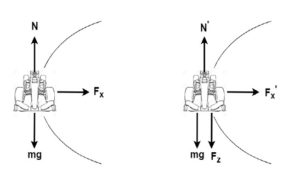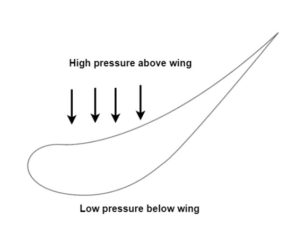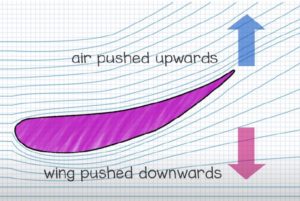Together with the engines, tires, roads, and drivers, vehicle aerodynamics is also gaining popularity in racing industry especially due to the application of negative lift principle, which results in significant improvement in performance. The body parts like wings, diffusers and vortex generators play an important role in optimizing the aerodynamics of racing cars . In this paper, we will briefly discuss about these design features and principles involved behind them. Vehicle aerodynamics is a broad term comprising engine intake and cooling flow, internal ventilation, tire cooling, and overall external flow. We, however, will only focus on the effects of external aerodynamics here.
Before we discuss the aerodynamics of racing cars, let us first discuss why the study of aerodynamics is important
Importance of Aerodynamic Study

Prior to 1960s the aerodynamic studies of racing cars mainly focused on drag reduction and stability. Vehicles were streamlined and they even had the vertical stabilizers at their rear end for lateral stability. It was after 1960s that the huge advantage of aerodynamics to improve the tire traction was realized which paved the way for racing cars to significantly improve their cornering speed without much slippage. The idea was to apply aerodynamics to generate the downwards force. First, it is important to understand how this downwards force improves cornering performance.
From figure 1 we can see that,
N = mg
N’ = mg + Fz
So,
Fx = µ N = µ mg
Clearly,
Fx’ > Fx
This means that the vehicle can move around the corner with greater limiting speed without any slippage.
Note that, Fx is linearly proportional to the small values of slip angle. So, racing cars generally move around the corner with some slippage, and with speed slightly greater than the limiting speed.
Had there not been downward force, the tires of the vehicle would leave the ground and the vehicle would somersault at high-speed cornering maneuver.
Generation of Downward Force
Now, we enter the prominent discussion for the aerodynamics of racing cars. We know that the downward force is generated by the pressure difference between the upper and the lower part of the vehicle. In case of racing cars, this pressure difference is generated by adding wings or by using the vehicle’s body.
i. With Front and Rear Wings

The wings of the racing cars are designed with inverted airfoil sections to create the downward lift as shown in figure 2. They produce around two-third of the total downward force.
The air below the wings has greater velocity than the air above, meaning that the lower section is the low pressure region. The downward force is exerted from the high pressure region (figure 2). Describing the same phenomenon in terms of Newton’s third law, the rear wing pushes the airflow upwards, and the same upward flowing air provides equal and opposite downward force to the vehicle (figure 3). Since the front face of the racing car is minimized and lowered to the ground for drag reduction, the front wings operate within strong ’ground effect’.

ii. With Vehicle’s Body
According to the incompressible flow theory, even the non-lifting bodies with close proximity to the ground develop downwards force, which is because of the ’ground effect’. Since racing cars are designed with low clearance between their underbody and ground, air moves with greater speed below the vehicle creating a low pressure region, and hence creating down-ward force. To make this process more efficient, some legit design features, like diffuser, and vortex generators, are used. Use of suction fans, and skirts were also in practice to accelerate the bottom air. Despite the wonderful performance of those designs, the racing regulations outlawed those designs especially owing to the safety of the drivers (for e.g. suction cars won from the day one of the creation, were outlawed, again repeated years later in Formula 1, won directly out of the box, again outlawed outright!),
The diffuser in the racing car accelerates the flow of air under the car, and creates a very low pressure region underneath, thereby increasing the downward force. This happens because the diffuser increases in volume along its length, creating a void that has to be filled by the air passing under the body. The Venturi effect accelerates the flow through the throat of the diffuser, creating the desired low pressure.
Vortex generators are simple add-ons to the existing car to increase the downforce. The vortices from vortex generators help to delay the flow separation at the bottom part of the wing, and also, reduce the pressure along their trail, both contributing the efficiency of downward force.
Concluding Remark
In this way, aerodynamics is one of the major premise in motor racing industry. However, since it is a highly competitive field, the results of the advanced researches are kept confidential. Despite this, the paper pretty much explains the basic idea (i.e. developing efficient downwards force) regarding the study of aerodynamics in motor racing industry.
Citation to Original Paper
Katz, Joseph. (2006). Aerodynamics of race cars. Annu. Rev. Fluid Mech. 38. 27-63. 10.1146/annurev.fluid.38.050304.092016.
Was this summary helpful?
Mention in the comments section below, and do not forget to check our other research summaries, and general blogs.








